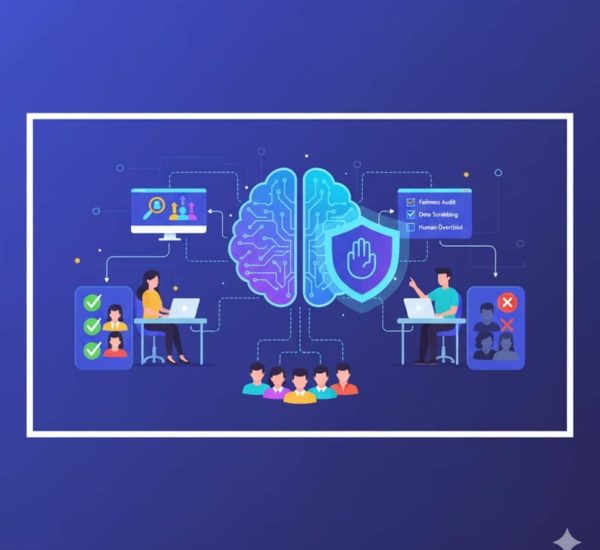Artificial intelligence has become the workplace’s favorite assistant – helping automate tasks, boost productivity, and even predict business trends. But beneath that promise lies a darker reality: AI-based scams are quietly reshaping how cybercriminals target organizations. From deep fake voice messages mimicking CEOs to hyper-personalized phishing emails, fraudsters are using the same tools that power modern workplaces to deceive employees with unnerving accuracy. For HR and operations leaders, this isn’t just a tech issue – it’s a people issue. Protecting teams from digital manipulation now requires more than a firewall or training module; it calls for building digital trust, awareness, and resilience across every level of the organization.
Understanding AI-Based Scams and Why They’re Rising
The term AI-based scams covers a growing wave of digital deception where cybercriminals use artificial intelligence to mimic human behavior, voices, or written communication with unsettling precision. Unlike traditional phishing attempts, these scams feel believable because AI can learn a person’s tone, habits, and even work relationships. Whether it’s a deep fake video instructing an urgent wire transfer or a chatbot pretending to be a trusted coworker, these attacks exploit the trust that defines workplace collaboration.
The surge in these threats is tied to the accessibility of AI tools. Open-source models, cloned voices, and automated chat systems have made AI social engineering easier and cheaper than ever. Meanwhile, hybrid work and digital-first communication create the perfect conditions for manipulation – where employees can’t always verify a face or voice in real time. This new era demands more than tech fixes; it requires organizations to strengthen employee cybersecurity awareness and create policies that prioritize AI fraud prevention from day one.

How AI Scams Target Employees: Common Tactics and Red Flags
As AI tools grow more advanced and accessible, cybercriminals are using them to make social engineering far more precise – and damaging. Below are key tactics through which AI-based scams target employees, along with warning signs (red flags) that organizations should watch out for.
1. Deep Fake Voice and Video Impersonation (AI-Impersonation Scams)
One of the most frightening tools in the scammer’s arsenal is deep face technology that clones a person’s voice or appearance. Attackers can take publicly available snippets – webinars, social media, earnings calls – and use them to train models that mimic a senior leader, executive, or colleague.
- In one high-profile case, the engineering firm Arup lost USD 25 million when an employee was tricked by a deepfake video conference call using cloned executives instructing financial transfers. (adaptivesecurity.com)
- Surveys indicate that a majority of finance professionals have already been targeted by deepfake schemes – 53 % in one study – and that over 43 % admitted some level of compromise. (IBM)
Red flags to watch for:
- Requests for financial transfers, wire instructions, or sensitive contract actions coming via voice or video without prior context or authentication.
- Inconsistencies in video or audio – slight lip-sync delays, unnatural pauses, distortion, or mismatches between what is spoken and what appears on screen.
- Pressure to act quickly or to “keep it quiet,” which reduces the chance the target will pause and verify.
2. Hyper-Personalized Phishing & AI-Augmented Spear Phishing
Traditional phishing emails often look generic or poorly written. But with AI-driven spear phishing, attackers use advanced models and open-source intelligence to craft messages that reference real projects, colleagues, internal systems, or recent company events.
- Some reports estimate that 82.6 % of phishing emails analyzed in recent periods show signs of AI assistance. (securitymagazine.com)
- Others report that global phishing attacks have risen nearly 60 % year-over-year, in part fueled by generative AI tools. (Zscaler)
- In controlled experiments, emails generated by large language models have performed about as well as those prepared by human experts, yielding click-through rates that challenge traditional defenses. (arXiv)
Red flags to watch for:
- Emails referencing internal details unexpectedly (e.g. departmental names, recent meetings, employee names) from “unknown” senders.
- Subtle deviations in tone, unusual or unfamiliar phrasing, or messages that don’t quite match the usual writing style of an internal contact.
- Urgent calls to action, such as “validate the transfer now,” “download this confidential file,” or “respond within hours,” without prior legwork.
- Links that seem legitimate but lead to slightly altered domains (e.g. “company-portal.com” vs. “company-prtal.com”), or disguised shortened URLs that bypass detection.
3. Fake Job Offers or External Partnership Requests
Another insidious tactic: attackers leverage AI to simulate recruiting outreach or collaboration proposals. For instance, employees might receive what looks like a legitimate offer from a sister company or partner via email, LinkedIn, or messaging apps. The message may ask the recipient to fill out a form, upload resumes, or even share internal access credentials “for onboarding.”
Red flags to watch for:
- Offers or proposals that are unsolicited, especially from unfamiliar companies or contacts.
- Requests to grant access to internal systems or share sensitive documents before verification.
- Pressure to comply quickly (e.g. “we need this now to process your onboarding”).
- Slight inconsistencies in branding (logo, email domains) or language imperfections.
4. Voice Cloning for Vishing (Voice Phishing)
Beyond video, audio deep fakes are increasingly being used to mimic executives in phone calls – even over VoIP or internal lines. Attackers may simulate the voice of a known leader, instructing frontline staff or accounts teams to authorize payments or data release.
- A 2023 McAfee survey noted one in ten people globally reported being targeted by an AI voice-cloning scam; of those, 77 % lost money. (Wikipedia)
- Deepfake scams are increasingly used in CEO fraud or business email compromise (BEC) schemes, where the attacker impersonates a boss’s voice to push an urgent fund transfer. (McAfee)
Red flags to watch for:
- An unusual phone call from leadership requesting sensitive actions without prior context.
- Speech that seems emotionally abrupt, or with hesitation, where the real person wouldn’t pause.
- The caller refuses to use a secondary verification method (e.g. “the CEO insisted this must remain confidential; don’t call back”).
5. Credential Harvesting via Malicious Chatbots or Fake Support
AI-powered chatbots and conversational agents are a new vector for employee-targeted scams. Attackers may deploy bots that pose as internal IT support or automated assistants, asking employees to re-enter credentials, license keys, or tokens, often during what seems like maintenance or rollout of new tools.
Red flags to watch for:
- Chatbots asking for password resets or asking for credentials directly.
- Unexpected prompts to “re-authenticate” via new webforms or tokens (particularly if the domain is unfamiliar).
- Responses that appear too generic or off-script in nature.
Case in Point: When AI Deception Hit the Boardroom
In early 2024, employees at the Hong Kong branch of a multinational firm believed they were attending a legitimate video meeting with their CFO and several colleagues. Every face on the screen looked familiar, every voice sounded right. But there was one problem – none of the real executives were actually present. The entire meeting had been staged using deepfake technology. The scammers, using AI-generated likenesses, convinced the finance team to transfer $25 million to fraudulent accounts.
The incident, confirmed by Hong Kong police, became one of the most sophisticated AI-based scams ever reported. It served as a wake-up call for companies worldwide, showing that even employees who follow standard verification protocols can be misled when deception looks and sounds human.
For HR, IT, and security leaders, this event underscored a critical truth: technology-driven fraud is no longer confined to technical teams. The line between cybersecurity and people strategy has blurred – and defending employees now means preparing them for manipulations that feel real.
Prevention Strategies | What HR & IT Can Do
Defending against AI-based scams isn’t just about installing better firewalls or antivirus software. It’s about creating a culture where employees understand that trust in digital communication must be earned, not assumed. HR and IT teams share the responsibility of making that happen – by building awareness, policy, and protection into daily operations.
1. Build a Human Firewall Through Awareness Training
The most advanced cybersecurity systems can still fall short if employees aren’t trained to spot deception. Regular awareness sessions should highlight how AI social engineering works – showing examples of deep fake scams, cloned voices, and fake chatbot interactions.
Organizations can integrate simulated phishing or voice-cloning drills to help employees practice identifying red flags in a controlled environment.
Training should go beyond IT – HR, finance, and leadership teams must also learn to verify requests through multi-channel communication, especially when high-value or sensitive information is involved. A simple callback or Slack confirmation can prevent multimillion-dollar losses.
2. Create AI Safety and Verification Policies
Clear AI safety policies are the foundation of prevention. Every organization should document protocols for verifying unusual or urgent requests, especially those involving money transfers, confidential data, or employee information.
Policies should include:
- Mandatory secondary confirmation for sensitive requests (e.g., voice plus written confirmation).
- Rules for using AI-generated content and tools internally.
- A protocol for reporting suspected AI impersonation or phishing attempts.
Regular updates are critical – as AI evolves, policies must evolve too. HR and IT should collaborate to make policy training part of onboarding and annual compliance refreshers.

3. Leverage AI to Fight AI
Ironically, the most effective defense against AI-based scams may be smarter AI itself. Modern AI fraud prevention platforms can detect deep fake artifacts, identify unnatural language patterns, and flag suspicious email metadata faster than human analysts.
Organizations can deploy:
- AI-powered email filters that analyze writing style consistency and detect cloned communication.
- Voice authentication systems that verify speech signatures before approving sensitive actions.
- Identity verification tools integrated into HR systems to ensure candidate legitimacy during hiring or remote onboarding.
4. Make Cybersecurity Part of Company Culture
Ultimately, employee cybersecurity is as much about mindset as it is about technology. Encourage teams to slow down before responding to high-pressure messages, reward employees who report suspicious activity, and normalize conversations around digital trust.
Leaders can model this by double-checking their own communications and encouraging transparency when something feels off. In many ways, the goal isn’t to make employees fear technology – it’s to make them confident in questioning it.
5. Partner with Experts and Conduct Regular Audits
External audits can help uncover blind spots internal teams may overlook. HR and IT should work with cybersecurity consultants to test systems for vulnerabilities, review internal AI tool usage, and assess how well employees can detect fraud attempts.
Regular audits also ensure compliance with regional data protection laws such as GDPR or CCPA, which now intersect closely with AI governance. In a world where new AI threats appear daily, proactive assessment beats reactive recovery.
Conclusion: Rebuilding Trust in the Age of Intelligent Deception
The rise of AI-based scams is a reminder that technology’s greatest strength – its ability to mimic and predict human behavior – can also become its greatest risk. As cybercriminals weaponize artificial intelligence to exploit human trust, organizations must respond not with fear, but with foresight. The future of employee cybersecurity depends on blending smart policies, awareness, and empathy.
HR and IT leaders hold the power to shape that balance. By investing in AI fraud prevention, continuous training, and open communication, they can ensure employees feel confident, not paranoid, about the tools they use. In a world where a voice or video can lie, the most powerful truth an organization can protect is its people’s trust.


